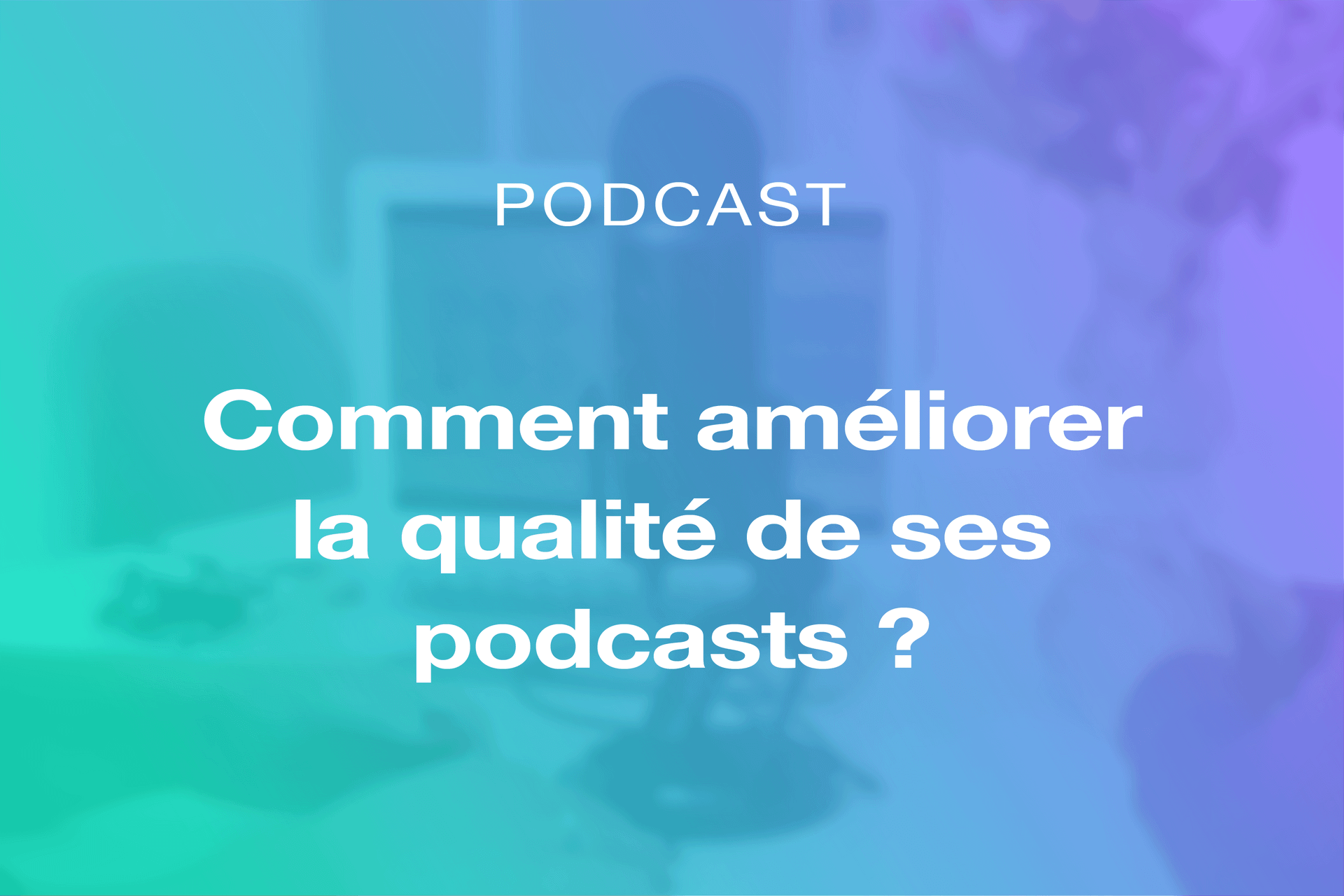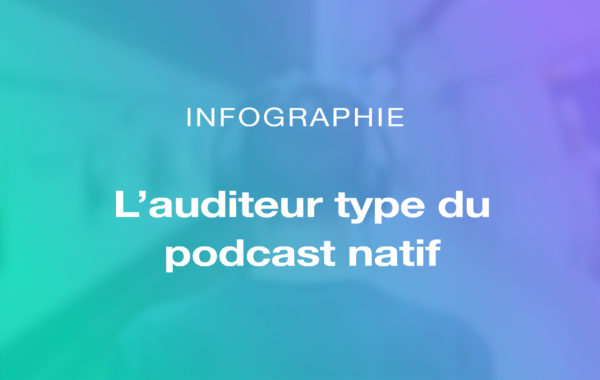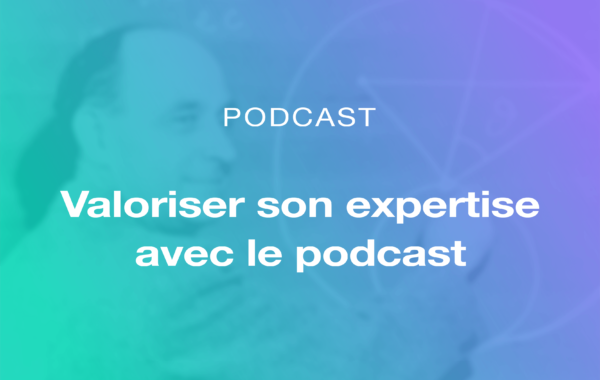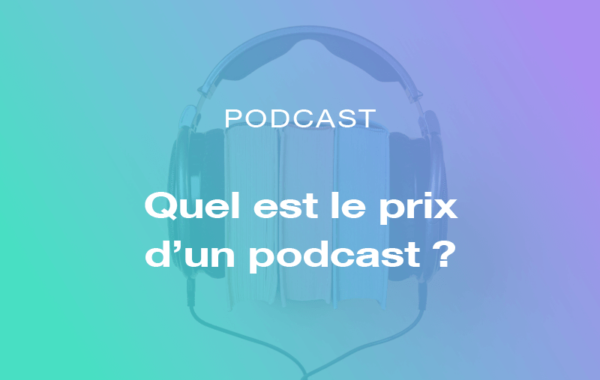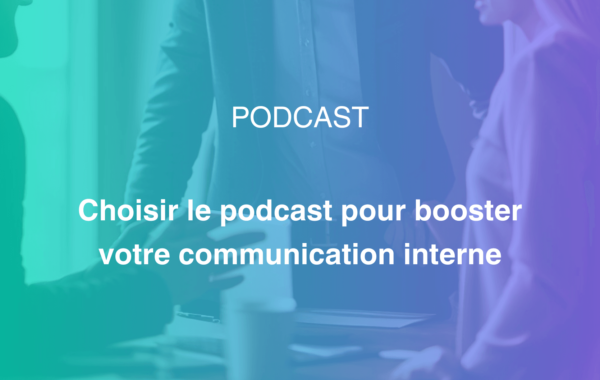Pourquoi et comment faire la post-production de ses podcasts ?
Désireux de lancer votre propre podcast ?
Que ce soit pour votre plaisir personnel, ou pour promouvoir votre marque (ou les deux), des détails techniques sont à prendre en compte.
Écoutez plutôt ces deux extraits (Sportcast – Sud Ouest) :
Avant la post-production Après la post-production
Vous avez entendu la différence ?
Celle qui frappe le plus, c’est le fait que la prise de parole du second interlocuteur monte brusquement en volume à un moment donné. Nous suspectons que la personne se soit approchée de son micro à ce moment-là, et parlait un peu plus fort que son collègue. Ce changement désagréable a été totalement corrigé au second passage, comme par magie. 🧙
Ce qui fait la différence, c’est la post-production. Analysons ensemble ce processus qui donne un rendu professionnel à un enregistrement.
I – Pourquoi faire de la post-production ?
🎚️ I – Pourquoi faire de la post-production ?
Techniquement, le podcast est accessible à tous. Tout ce dont nous avons besoin, c’est quelque chose à dire, et un micro. Cependant nous avons vu en introduction la différence que fait la post-production, et celle-ci est essentielle pour proposer un contenu audio de qualité.
Découvrons la plus value de la post-production, sur la qualité de vos podcasts.
Lissage du son, ou l’équilibrage des voix
Dès que nous entendons plus d’une voix lors d’un enregistrement, un lissage du son est nécessaire. Il suffit qu’une personne parle un peu plus loin de son micro, et nous avons soudainement envie de monter le volume de notre téléphone lors de ses prises de paroles. Pas très pratique ! Dans l’autre sens, il suffit d’un éclat de rire pour que nous sursautions et que nous voulions baisser le son pour quelques secondes…
Bref, ne pas toucher à son volume lorsque l’on écoute un podcast est un confort que l’on considère trop souvent acquis. Un podcast de qualité professionnelle est un podcast qui garantit ce confort. Une des premières phases de travail lors de la post-production consiste donc en un lissage du son et un équilibrage des voix.
Sons parasites et erreurs de voix
Dans la catégorie des petites choses qui nous agacent, les “euhh” et les “huums” sont très bien classées. Ces “erreurs” ralentissent le podcast, et peuvent même détourner l’attention si elles sont trop récurrentes.
D’autres sons parasites, tels que des bruits de table, un stylo qui tombe, un grincement de chaise sont atténuables, mais seulement dans une certaine mesure (l’ingénieur son n’est pas un magicien).
Un autre aspect qui est pris en compte lorsque l’on s’attaque à la post production est le bruit de fond. Selon l’endroit où est enregistré le podcast, que ce soit dans la rue ou dans une pièce vide, différents problèmes d’environnement vont être soulevés. Que ce soit pour réduire un écho, ou dégager la parole qui nous intéresse des brouhahas d’une foule, la post-production sera une étape indispensable pour un rendu intéressant.
Homogénéité de la qualité des différents épisodes
Lors d’un podcast, il est possible que les différents interlocuteurs ne se trouvent pas dans la même pièce. Lors de l’intervention d’un expert par exemple, on peut se retrouver avec l’enregistrement d’un appel téléphonique, qui sera de moins bonne qualité que l’enregistrement venant d’un micro dans une pièce vide. Grâce à la post-production, il est possible d’homogénéiser plusieurs enregistrements, afin de ne pas avoir une différence trop importante. On remarquera toujours une différence, mais il est possible de l’atténuer !
De la même façon, si vous changez d’environnement entre deux podcasts, ou même en plein milieu d’un podcast, il est possible d’atténuer les bruits de fond et ainsi arriver à une qualité homogène sur l’ensemble de l’épisode.
Ajout d’éléments sonores
Un podcast n’est que très rarement composé uniquement d’une voix. La plupart du temps, on y ajoute des éléments sonores tels qu’un générique, de la musique ou des bruitages pour des podcasts narratifs.
Pour insérer ce type de composant, il est nécessaire d’effectuer un certain travail de mixage, afin que le tout soit cohérent, et que certaines fréquences n’entrent pas en conflit.
Par exemple : si vous décidez de laisser l’auditeur écouter votre générique pendant quelques secondes, avant de prendre la parole par dessus, il va falloir baisser le volume à un moment précis pour que l’on puisse vous comprendre.
🎛️ II – En quoi consiste la post-production, concrètement ?
Voyons maintenant certains des principaux traitements que l’on peut appliquer à un enregistrement sonore. Nous n’entrerons pas dans les détails, car cela nécessiterait d’écrire plusieurs ouvrages. C’est un métier qui allie créativité et technicité.
Stéréo et mono
Il est possible qu’après avoir enregistré son podcast, le son varie entre l’oreille gauche et l’oreille droite. Il est essentiel de maîtriser sa spatialisation lors de la post-production. Nous allons donc parler de signaux mono et stéréo.
Le signal mono est diffusé sur un seul canal, comme provenant d’une seule source, alors que le signal stéréo est le résultat de l’assemblage de deux signaux monos.
Si l’on prend en compte les conditions d’écoutes du podcast, on se rend compte que celles-ci seront rarement optimales. En courant, dans les transports, en faisant le ménage, il peut arriver que vos auditeurs décident de vous écouter avec une seule oreille.
Dans ce cas-là, il faut faire très attention à l’usage du stéréo. Utilisé surtout dans le podcast de fiction pour nous immerger dans un univers particulier, il n’a que très peu d’intérêt lorsqu’il s’agit par exemple d’une interview, et peut être préjudiciable si l’écoute se fait à une oreillette et que l’on manque la moitié des interventions et prises de parole.
Lors de la post-production, nous allons donc veiller à passer l’ensemble des pistes en mono dans un premier temps. Et si le format s’y prête, il sera ensuite possible de procéder à une spatialisation manuelle.
Suppression des “hums” et silences
Afin d’assurer la phase de post-production, l’ingénieur du son utilise un DAW (Digital Audio Workstation). Cette station audionumérique qui était dans un premier temps physique est devenue virtuelle, avec des logiciels gratuits pour certains. (comme Audacity).
Grâce à ces derniers, il est possible de tout simplement couper l’enregistrement afin de retirer les silences, les “euhs”, “hums” qui parasitent le propos. Cette étape est aussi essentielle afin de dynamiser le podcast, car même si votre prise de parole est parfaite, celle d’un expert ou d’un interlocuteur qui n’est pas habitué au format peut ne pas l’être.
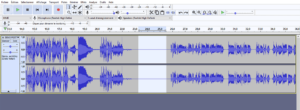
Crossfade
Pratique largement répandue dans sa forme visuelle pour le cinéma, le fondu peut aussi être sonore. Technique d’enchaînement entre deux pistes, elle sert comme une marque de ponctuation.
Le fondu le plus technique est le fondu enchaîné, ou cross-fade. Le volume baisse petit à petit, pour laisser place à un autre son qui monte jusqu’à son volume normal. Il peut servir comme transition dans un podcast entre deux interlocuteurs, ou pour introduire un morceau de musique par exemple.
Égaliseur, suppression des plosives
L’égaliseur (equalizer, equaliser, ou “EQ”), est l’appareil ou logiciel qui permet de filtrer, ou d’amplifier différentes bandes de fréquences dans un signal audio. Utilisable en plein enregistrement comme en post-production, c’est un outil essentiel pour assurer la qualité de votre podcast.
Il va nous permettre de superposer l’habillage sonore avec la voix, en gérant les fréquences, et ainsi éviter qu’une fréquence ne sature car surchargée.
Même si l’égaliseur est utile dans de nombreux autres cas, ici, il va nous intéresser dans l’objectif de supprimer les plosives. Ce sont les consonnes qui génèrent des “pops”, comme les sons “b”, “p” et “t”. Très désagréables à l’oreille, il est préférable de les atténuer. Même si l’on ne dispose pas d’un filtre anti-pop directement sur le micro, on peut « sauver » l’enregistrement en utilisant un égaliseur, et plus précisément sa fonction filtre passe-haut, qui laisse passer les hautes fréquences et atténue les basses fréquences. High-pass en anglais.
Compression
Comme démontré dans l’introduction, le volume d’un enregistrement peut varier selon certains facteurs. La compression est le procédé grâce auquel nous n’avons pas besoin de toucher à notre bouton de volume !
Imaginons qu’un des interlocuteurs que l’on entend dans votre podcast parle à un volume plus bas que les autres. Imaginons ensuite, qu’il rit extrêmement fort. Grâce à la compression, la personne assurant la post-production va pouvoir réduire l’écart entre ces deux volumes en un clic.
Il devra simplement renseigner un seuil de décibel. Si le signal audio le dépasse, il est atténué, en fonction du ratio choisi.

🎧 III – La post-production, un travail d’ingénieur son.
Cela peut faire beaucoup d’informations à intégrer d’un coup, et maîtriser tous ces éléments techniques peut représenter une quantité de temps et de travail conséquent. C’est pourquoi certains préfèrent confier la post-production de leur podcast à des services d’édition.
Se concentrer sur son contenu plutôt que sur des heures de mixing peut être un soulagement pour tout podcasteur. Tout ce temps passé “en dehors” de votre activité principale vous empêche aussi d’écrire un nouveau podcast.
De plus, tous les tutoriels sur YouTube et toute la volonté du monde ne vaudra pas l’expérience et l’expertise d’un professionnel du son. Cette solution assure la régularité de la qualité de votre série de podcasts.
Plus d’articles :
Why and How to Make the Post-Production of Your Podcasts ?
Want to launch your own podcast ?
Whether it’s for your personal pleasure, or to advertise your brand (or both), there are technical details to consider.
Listen to these two extracts (Sportcast – Sud Ouest) :
Before the post-production
After the post-production
Did you hear the difference ?
The one that strikes us the most is the fact that the second speaker’s speech suddenly increases in volume at one point. We suspect that the person came closer to his microphone at that moment, and spoke a little louder than his colleague. This unpleasant change was completely corrected in the second part, just like magic.
What makes the difference is post-production. Let’s analyze this process that gives a professional look to a recording.
I – Why Make Post-Production ?
🎚️ I – Why Make Post-Production ?
Technically, the podcast is accessible to everyone. All we need is something to say and a microphone. However, we saw in the introduction the difference that post-production makes, and it is essential to offer good quality audio content.
Let’s discover the added value of post-production on the quality of your podcasts.
Sound Smoothing, or Vocal Balancing
As soon as we hear more than one voice during a recording, sound smoothing is necessary. All it takes is for someone to speak a little further away from the microphone, and we suddenly feel like turning up the volume on our phone when they speak. Not very practical ! On the other way, a burst of laughter is enough to make us overly suspicious and want to turn down the volume for a few seconds…
In short, not touching the volume when listening to a podcast is a comfort that is too often taken for granted. A professional quality podcast is a podcast that guarantees this comfort. One of the first phases of work during post-production is to smooth the sound and balance the voices.
Static Sounds and Vocal Errors
In the category of little things that annoy us, the « uhh » and « huums » are ranked very high. These « mistakes » slow down the podcast, and can even distract if they are too recurrent.
Other static sounds, such as the noises of a table, a falling pen, or the squeaking of a chair can be reduced, but only to a certain extent (the sound engineer is not a magician).
Another aspect that is taken into account when tackling post-production is background noise. Depending on where the podcast is recorded, whether it’s on the street or in an empty space, different environmental issues will arise. Whether it is to reduce an echo or to clear the speech we are interested in from the hubbub of a crowd, post-production will be an essential step for an interesting rendering.
Homogeneity of the Different Episodes’ Quality
During a podcast, it could be possible that the different speakers are not in the same room. For example, when an expert speaks, you may end up with a recording of a phone call, which will be of poorer quality than a recording from a microphone in an empty room. Thanks to post-production, it is possible to homogenize several recordings, so that there is no big difference. You will always notice a difference, but it is possible to reduce it !
In the same way, if you change the environment between two podcasts, or even in the middle of a podcast, it is possible to reduce the background noise and thus achieve a homogeneous quality throughout the episode.
Adding Sonic Elements
A podcast is very rarely composed only of a voice. Most of the time, we add sound elements such as credits, music or sound effects for narrative podcasts.
To insert this type of component, it is necessary to do some mixing work, so that everything is coherent, and that certain frequencies do not contradict.
For example : if you decide to let the listener listen to your credits for a few seconds, before speaking over them, you will have to lower the volume at a certain point so that they can understand you.
🎛️ II – What Does this Mean in Concrete Terms ?
Let’s now look at some of the main techniques that can be applied to a sound recording. We will not go into detail, as this would require writing several books. It is a job that combines creativity and technicality.
Stereo & Mono
It is possible that after recording your podcast, the sound varies between the left and right ears. It is essential to master its spatialization during post-production. We will therefore talk about mono and stereo signals.
The mono signal is broadcasted on a single channel, as coming from a single source, whereas the stereo signal is the result of the blending of two mono signals.
If we take into account the listening conditions of the podcast, we realize that they will rarely be optimal. While running, in the transport, while doing the housework, it’s possible that your listeners decide to listen to you with only one ear.
In this case, we must be very careful with the use of stereo. Used especially in the fiction podcast to immerse us in a particular universe, it has very little value when it is for example an interview and can be prejudicial if the listening is done with an earpiece and that one misses the half of the interventions and speeches.
During post-production, we will therefore make sure that all the tracks are in mono at first. And if the format is suitable, it will then be possible to proceed with manual spatialization.
Removal of “Hums” and Silences
In order to ensure the post-production phase, the sound engineer uses a DAW (Digital Audio Workstation). This digital audio station that was at first physical became virtual, with free software for some. (like Audacity).
Thanks to these, it is possible to simply cut the recording in order to remove the silences, the « euhs », « hums », that interfere with the speech. This step is also essential in order to dynamize the podcast, cause even if your speech is perfect, the speech of an expert or of a speaker who is not used to the format may not be.

Cross-fade
A largely widespread practice in its visual form for the cinema, the fade can also be sonic. A technique of linking two tracks, it serves as a punctuation mark.
The most technical fade is the linked fade or the cross-fade. The volume lowers little by little, to make room for another sound that rises to its normal volume. It can be used as a transition in a podcast between two speakers, or to introduce a piece of music for example.
Equalizer, Removal of Occlusives
The equalizer (or « EQ »), is the device or software that allows to filter or amplify different frequency bands in an audio signal. It can be used in the recording process as well as in post-production, and it is an essential tool to ensure the quality of your podcast.
It will allow us to superimpose the sound design with the voice, by managing the frequencies, and thus avoid overloading a frequency.
Even if the equalizer is useful in many other cases, here it will be interesting to remove the plosives. These are the consonants that generate « pops« , like the « b », « p » and « t » sounds. They are very unpleasant to the ear and should be reduced. Even if you don’t have an anti-pop filter directly on the microphone, you can « save » the recording by using an equalizer, and more precisely its high-pass filter function, which lets high frequencies pass and reduces low frequencies.
Compression
As shown in the introduction, the volume of a recording can vary depending on certain factors. Compression is the process by which we don’t need to touch our volume button !
Let’s imagine that one of the speakers in your podcast speaks at a lower volume than the others. Then imagine that he is laughing extremely loudly. Thanks to compression, the person doing the post-production will be able to reduce the gap between these two volumes with one click.
He will simply have to enter a decibel threshold. If the audio signal exceeds it, it is diminished, depending on the ratio chosen.

🎧 III – Post-Production, a Sound Engineer’s Job.
That can be a lot of information to take in at once, and mastering all these technical elements can take a significant amount of time and work. That’s why some people prefer to entrust the post-production of their podcast to editing services.
Focusing on your content instead of mixing hours can be a relief for any podcaster. All that time spent « outside » of your main business also takes away from writing a new podcast.
Plus, all the tutorials on YouTube and all the will in the world won’t be worth the experience and expertise of a sound professional. This solution ensures the consistent quality of your podcast series.
Need help with the post-production of your podcast ?
Gain time and quality with professional post-production !

More articles :
Comments are closed.

